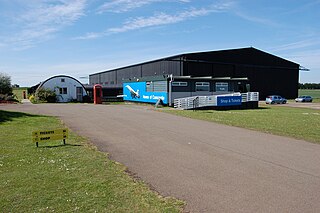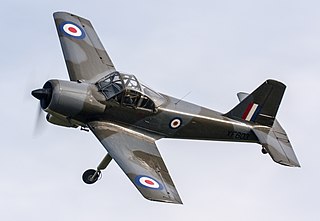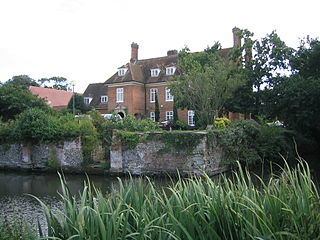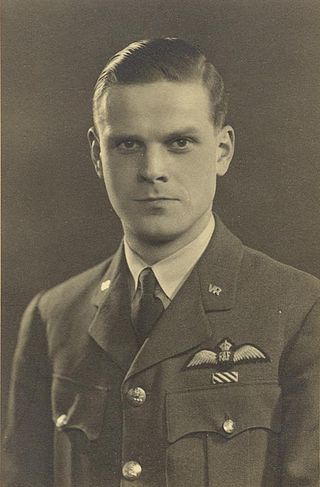
Sywell Aerodrome is the local aerodrome serving the towns of Northampton, Wellingborough, Kettering and Rushden, as well as wider Northamptonshire. The aerodrome is located 5 nautical miles northeast of Northampton and was originally opened in 1928 on the edge of Sywell village.

Brooklands was a 2.767-mile (4.453 km) motor racing circuit and aerodrome built near Weybridge in Surrey, England, United Kingdom. It opened in 1907 and was the world's first purpose-built 'banked' motor racing circuit as well as one of Britain's first airfields, which also became Britain's largest aircraft manufacturing centre by 1918, producing military aircraft such as the Wellington and civil airliners like the Viscount and VC-10.

The Hawker Hunter is a transonic British jet-powered fighter aircraft that was developed by Hawker Aircraft for the Royal Air Force (RAF) during the late 1940s and early 1950s. It was designed to take advantage of the newly developed Rolls-Royce Avon turbojet engine and the swept wing, and was the first jet-powered aircraft produced by Hawker to be procured by the RAF. On 7 September 1953, the modified first prototype broke the world air speed record for aircraft, achieving a speed of 727.63 mph.

The British Aerospace 125 is a twinjet mid-size business jet. Originally developed by de Havilland and initially designated as the DH.125 Jet Dragon, it entered production as the Hawker Siddeley HS.125, which was the designation used until 1977. Later on, more recent variants of the type were marketed as the Hawker 800.

The Handley Page HP.137 Jetstream is a small twin-turboprop airliner, with a pressurised fuselage. The aircraft was designed to meet the requirements of the United States commuter and regional airline market. The design was later improved and built by British Aerospace as the BAe Jetstream 31 and BAe Jetstream 32, featuring different turboprop engines.

The National Museum of Flight is Scotland's national aviation museum, at East Fortune Airfield, just south of the village of East Fortune, Scotland. It is one of the museums within National Museums Scotland.

Imperial War Museum Duxford is a branch of the Imperial War Museum near Duxford in Cambridgeshire, England. Britain's largest aviation museum, Duxford houses the museum's large exhibits, including nearly 200 aircraft, military vehicles, artillery and minor naval vessels in seven main exhibition buildings. The site also provides storage space for the museum's other collections of material such as film, photographs, documents, books and artefacts. The site accommodates several British Army regimental museums, including those of the Parachute Regiment and the Royal Anglian Regiment.

Royal Air Force Hooton Park or more simply RAF Hooton Park, on the Wirral Peninsula, Cheshire, is a former Royal Air Force station originally built for the Royal Flying Corps in 1917 as a training aerodrome for pilots in the First World War. During the early/mid-1930s, it was one of the two airfields handling scheduled services for the Merseyside region. Hooton Park was home to No. 610 Squadron and, post Second World War, to No. 611 and No. 663 (AOP) Squadron.

Newark Air Museum is an air museum located on a former Royal Air Force station at Winthorpe, near Newark-on-Trent in Nottinghamshire, England. The museum contains a variety of aircraft.

Hawarden Airport, also known as Hawarden Aerodrome, is an airport near Hawarden in Flintshire, Wales, near the border with England and 3.5 NM west southwest of the city of Chester.

The Fleet Air Arm Museum is devoted to the history of British naval aviation. It has an extensive collection of military and civilian aircraft, aero engines, models of aircraft and Royal Navy ships, and paintings and drawings related to naval aviation. It is located on RNAS Yeovilton airfield, and the museum has viewing areas where visitors can watch military aircraft take off and land. At the entrance to the museum are anchors from HMS Ark Royal and HMS Eagle, fleet carriers which served the Royal Navy until the 1970s. It is located 7 miles (11 km) north of Yeovil, and 40 miles (64 km) south of Bristol.

The de Havilland DH.60 Moth is a 1920s British two-seat touring and training aircraft that was developed into a series of aircraft by the de Havilland Aircraft Company.

The Percival P.56 Provost is a basic trainer aircraft that was designed and manufactured by British aviation company Percival.
The North East Land, Sea and Air Museums (NELSAM), formerly the North East Aircraft Museum, is a volunteer-run aviation museum situated on the site of the former RAF Usworth/Sunderland Airport, between Washington and Sunderland, in Tyne and Wear, England. The museum has the largest aviation collection between Yorkshire and Scotland and houses over 30 aircraft and a wide collection of aero engines. The museum also has a small collection of other items such as weaponry, vehicles and other historical exhibits.
Hatfield Aerodrome was a private airfield and aircraft factory located in the English town of Hatfield in Hertfordshire from 1930 until its closure and redevelopment in the 1990s.

Samlesbury Aerodrome is a disused airfield at Balderstone near Samlesbury and Blackburn in the Ribble Valley district of Lancashire. The aerodrome is owned by defence company BAE Systems which uses the site for the manufacture of several different aircraft. Currently the company employs approximately 3,000 people at the site. The aerodrome is part of Lancashire Enterprise Zone.

The de Havilland Aeronautical Technical School was founded in 1928, initially to provide owners of de Havilland Moth aircraft with technical maintenance skills.
The South Yorkshire Aircraft Museum (SYAM) is a Volunteer led museum located at Lakeside in Doncaster, South Yorkshire, England. It occupies the former site of the Royal Air Force Station, RAF Doncaster. The museum occupies the last remaining original buildings from RAF Doncaster in the shape of a Bellman hangar, two wooden Air Ministry 'Billet Huts' (Buildings 19 and 21) and various smaller structures. The museum has also erected an more modern ex Air Training Corps Cadet Hut alongside Building 21 to house its World War Two Collection.

Wing Commander Peter Stanley James, was a pilot in the Royal Air Force Volunteer Reserve during the Second World War, flying in RAF Bomber Command with No. 35 Squadron, No. 78 Squadron and No. 148 Squadron.

The Ulster Aviation Society (UAS) is a charitable organisation run entirely by volunteers with a wide interest in aviation, with a focus of "furthering a public interest in the history of aviation". It has a Heritage Collection based at Long Kesh, Lisburn, Northern Ireland. housing around 40 military and civil aircraft and rotorcraft along with vehicles and a large number of related items.



















